This Turkish flatbread, known as bazlama, is a yeasted flatbread that’s easy to make and tastes amazing. These are the ultimate thick and fluffy flatbreads. Cooked in a pan, they’re so fun to watch as they cook, and bubble. The satisfaction of watching them puff up in the pan never gets old.
They have the most amazing soft, fluffy and chewy texture with a slightly crisp outside. Serve them up fresh and warm and you’ll never turn back. Falling somewhere between a naan and a pita, this leavened flatbread is made tender by Greek yogurt – which also adds a little tang.
I’ve been wanting a good recipe to make fluffy flatbreads from scratch for so very long and I’ve finally got it. This pliable, tasty bread is perfect for wrapping up roasted or grilled meats and vegetables, just like I did for these lamb souvlaki.
If you’re looking for a quicker flatbread recipe, try this 3 ingredient flatbread.
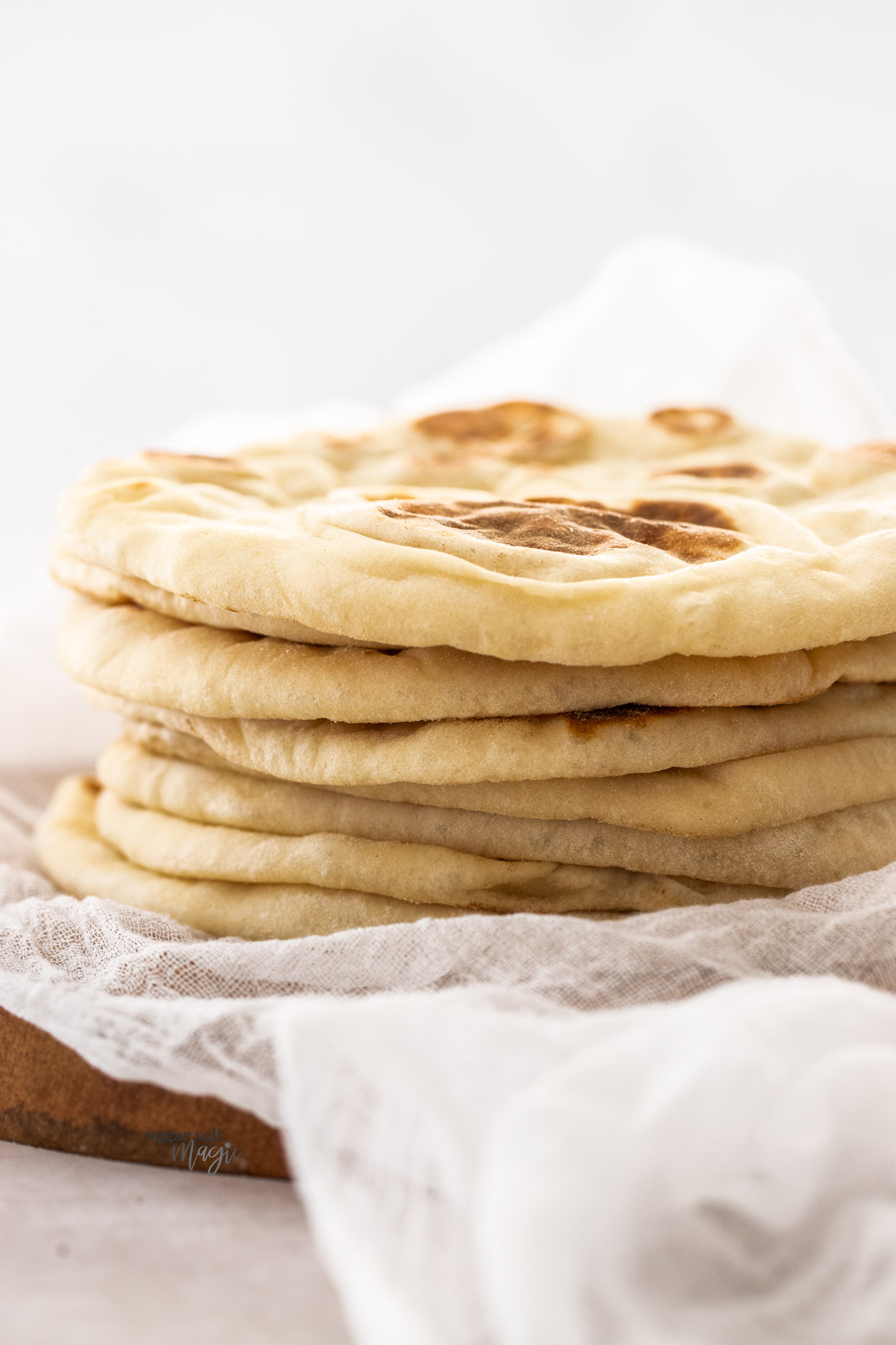
Never Miss a Recipe!
Get the latest recipes straight to your inbox!
What is bazlama?
Similar to naan and pita bread and known as “village bread”, bazlama is a yeasted yogurt flatbread. The yogurt ensures tenderness and a little tang while the yeast ensures fluffiness, like the best bready pillow. In Turkish culture it is traditionally cooked in an outdoor oven/wood fire oven though on the stove top works just fine.
It’s typically eaten warm and fresh, for breakfast and in a number of ways ranging from being brushed with butter and herbs to being filled with roast meats and vegetables. You can eat it, like I do, for soaking up curry sauces too – so, so good.
I first came across bazlama while searching wildly on google for the fluffiest of fluffy flat breads and it was the tortilla channel recipe that enticed me to try creating my own. My Turkish flatbread recipe is not truly authentic; I add a touch of baking powder to make it extra puffy, and to cut down on the hours long fermentation traditionally used, but other than that it’s very reminiscent of a good bazlama recipe.
Ingredients you’ll need
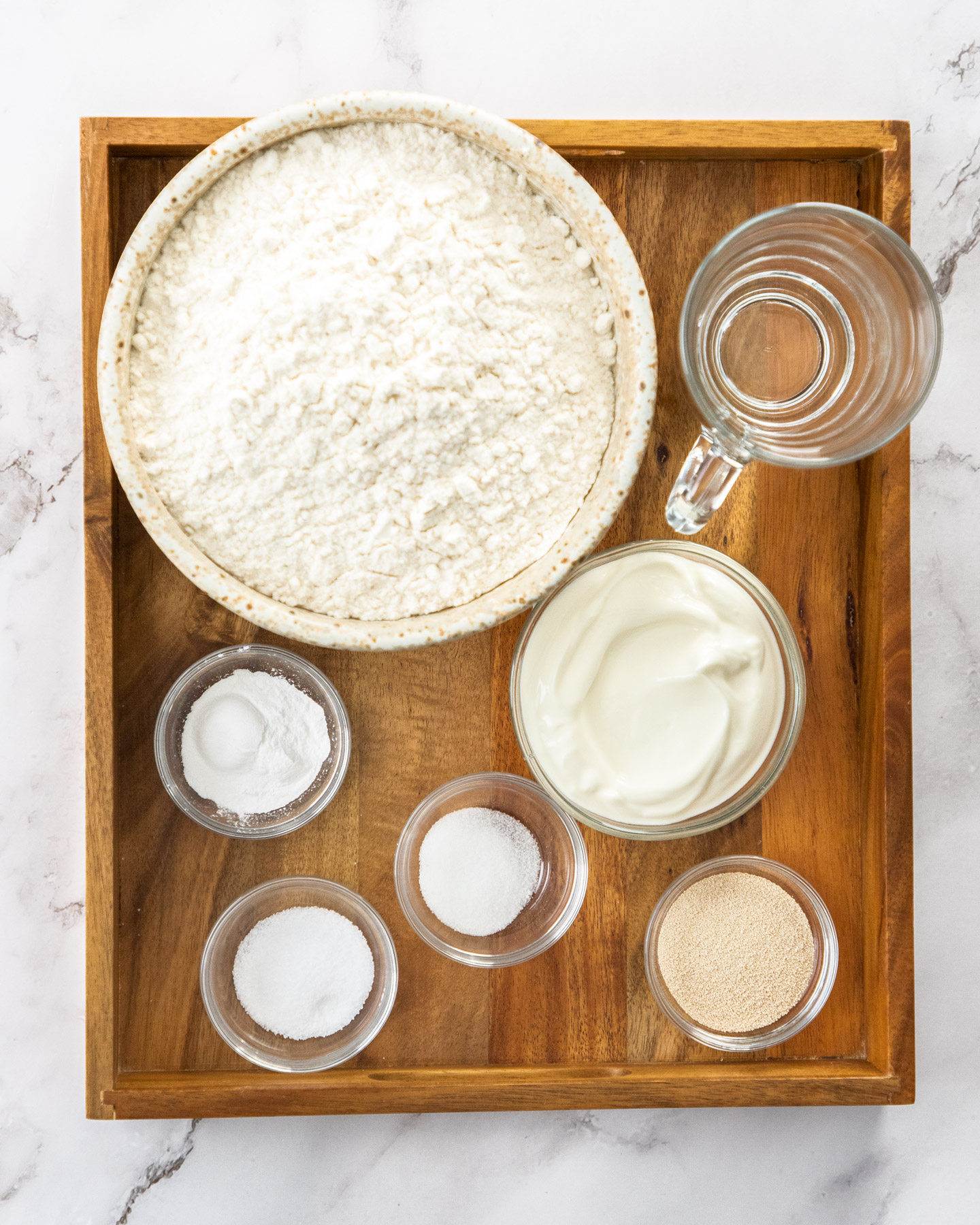
Detailed quantities and instructions in the recipe card below.
- Instant dry yeast: Instant dry yeast is used to leaven the bread – to add rise. It’s easy to use so if you haven’t made bread before don’t be intimidated. The most important things when using yeast are to not burn it by using hot water and make sure your yeast is fairly fresh and within it’s expiry date.
- Sugar: Just a little granulated sugar is all you need but brown sugar works fine too.
- Plain flour: Plain flour (aka all purpose flour) makes up the largest portion of ingredients.
- Greek yogurt: Use full fat Greek yogurt for the best result.
- Salt: Just a little salt for flavour.
- Baking powder: Baking powder is not traditional and it is optional here but I find it adds just a little extra puff that you don’t get by skipping the traditional 3 hour fermentation.
How to make Turkish flatbread (step-by-step)
While this is a dough that requires kneading and resting, it’s all very easy. I use a stand mixer, mainly so that I can be doing other things but it also stops me from being tempted to add too much flour when the dough is sticking to my hands – too much extra flour will dry it out.
You can of course knead it by hand, just as it would be done traditionally and it can be quite therapeutic, but it is a sticky dough and you need to be patient with it. Allow it time to get springy and smooth, without being tempted to add too much flour. If kneading by hand, a dough scraper is so helpful. Knead with one hand then use the scraper to help lift it from the bench.
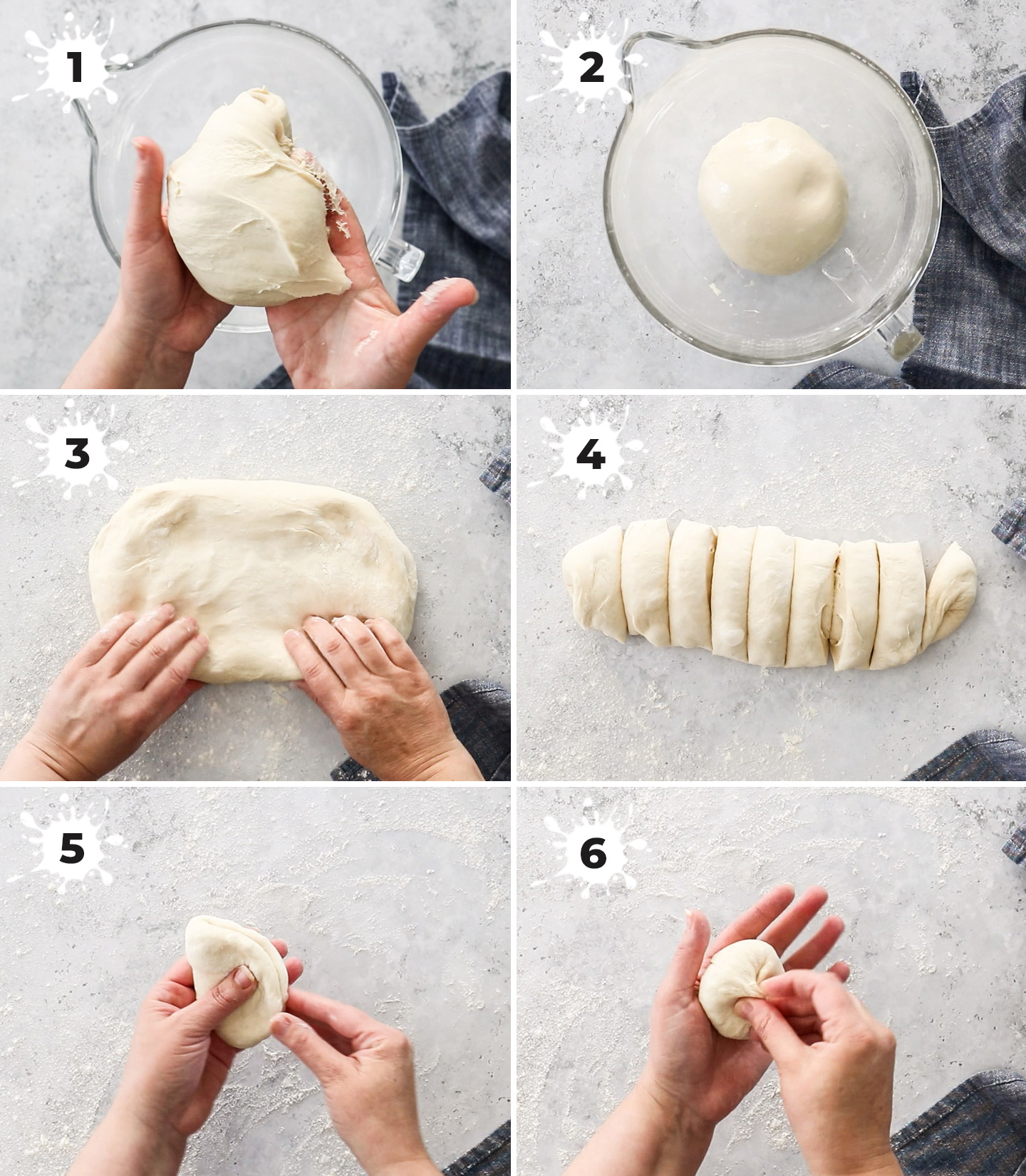
Detailed quantities and instructions in the recipe card below.
- Activate the yeast: While instant dry yeast does not require activation, I always take this step anyway because I can see easily if the yeast is good without wasting all the ingredients and time to only find out that it’s not rising because my yeast is no good. Just mix it with warm water and sugar and wait 5-10 minutes to make sure it gets frothy.
- Combine the ingredients: Now mix all the ingredients together in a (photo 1) large mixing bowl (I use a stand mixer).
- Knead the dough: Knead the dough for 7-10 minutes until it’s looking smooth and elastic (photo 1).
- Rest the dough: Place it into an oiled bowl (photo 2) and cover with plastic wrap to protect it from drafts and drying out. Keep it in a warm (not hot) place until it doubles in size – about 1 hour.
- Fold the dough: Lift the dough out and place it on a lightly floured surface. Shape it into a rectangle (photo 3) then fold the dough, a bit like a letter or just roll it up.
- Cut and shape: Cut the dough into 9 pieces (photo 4). Take one piece and fold it in half (photo 5), then, with it sitting in the palm of one hand, start pinching in the sides with the other hand, until the underneath is smooth and you have a little round ball (photo 6).
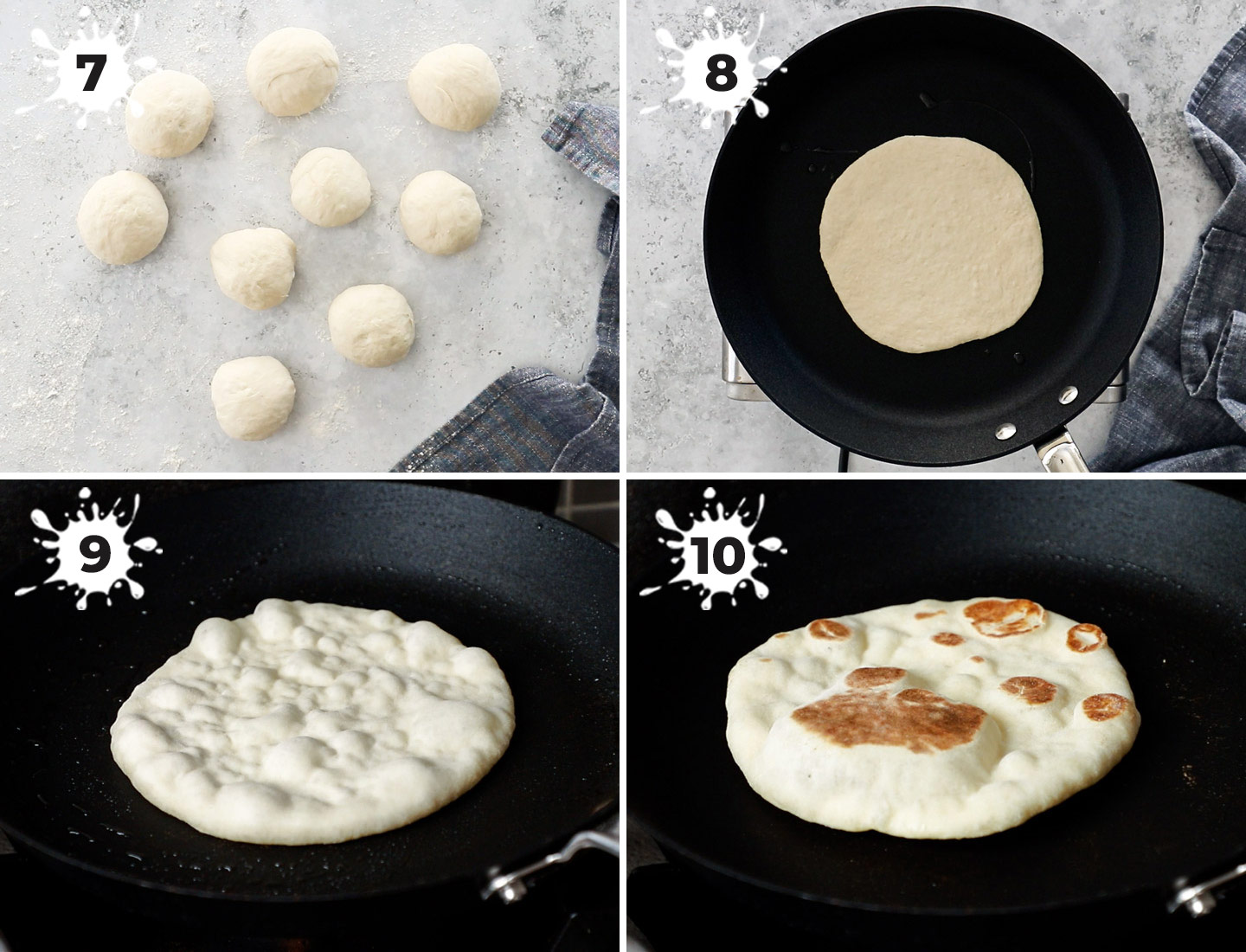
- Second rest: Rest the dough balls (photo 7) under a clean kitchen towel for 15-20 minutes.
- Roll: Heat a large skillet or frying pan over medium high and add a little drizzle of oil. Wipe it out with paper towel so there is just a light smear of oil in the pan. Roll out three of the dough balls to about 7 inches/18cm each. Return to the first and give it a light roll again to make sure it’s the 7 inches, then place it into the frypan (photo 8).
- Cook the flatbread: Cook for 1 minute until bubbles appear all over (photo 9), then flip and cook for a further 45 seconds (photo 10) – you should see it puff up like a little bread balloon. Flip and cook a further 10 seconds, then transfer to a plate covered with a clean tea towel.
You can keep rolling while one is cooking so that you always have 3 ready to go and each is getting it’s chance to rest again. If you get really good, you can have two pans going at once though it’s best to align the timing so you only have to keep track of one timer.
If you want to get super authentic, leave out the baking powder and let the dough ferment for 3 hours instead of the 1 hour rising time. The long fermentation adds extra tang and flavour to the bread.
How to serve Turkish flatbread
Use Turkish bread the same way you’d use naan or pita bread.
- Dipping: Sop up stew and curry sauce. Dip it into oil and dukkah – love that! Or use other dips like hummus or even labneh.
- Wrapping: Use them to wrap up any fillings you like.
- Garlic bread: Brush it with garlic butter and herbs and toast under a broiler/overhead grill.
- Fill it: As they form a pocket inside, you can fill it with cheese and cook on a griddle pan until melty.
- Pizza: I also love turning any leftover flatbreads into mini freezer pizzas. Top them with your favourite pizza toppings and freeze with a layer of baking paper between each. I cook mine in the air fryer for 8 minutes at 180C/350F but you can also cook them in the oven for 15 minutes or so.
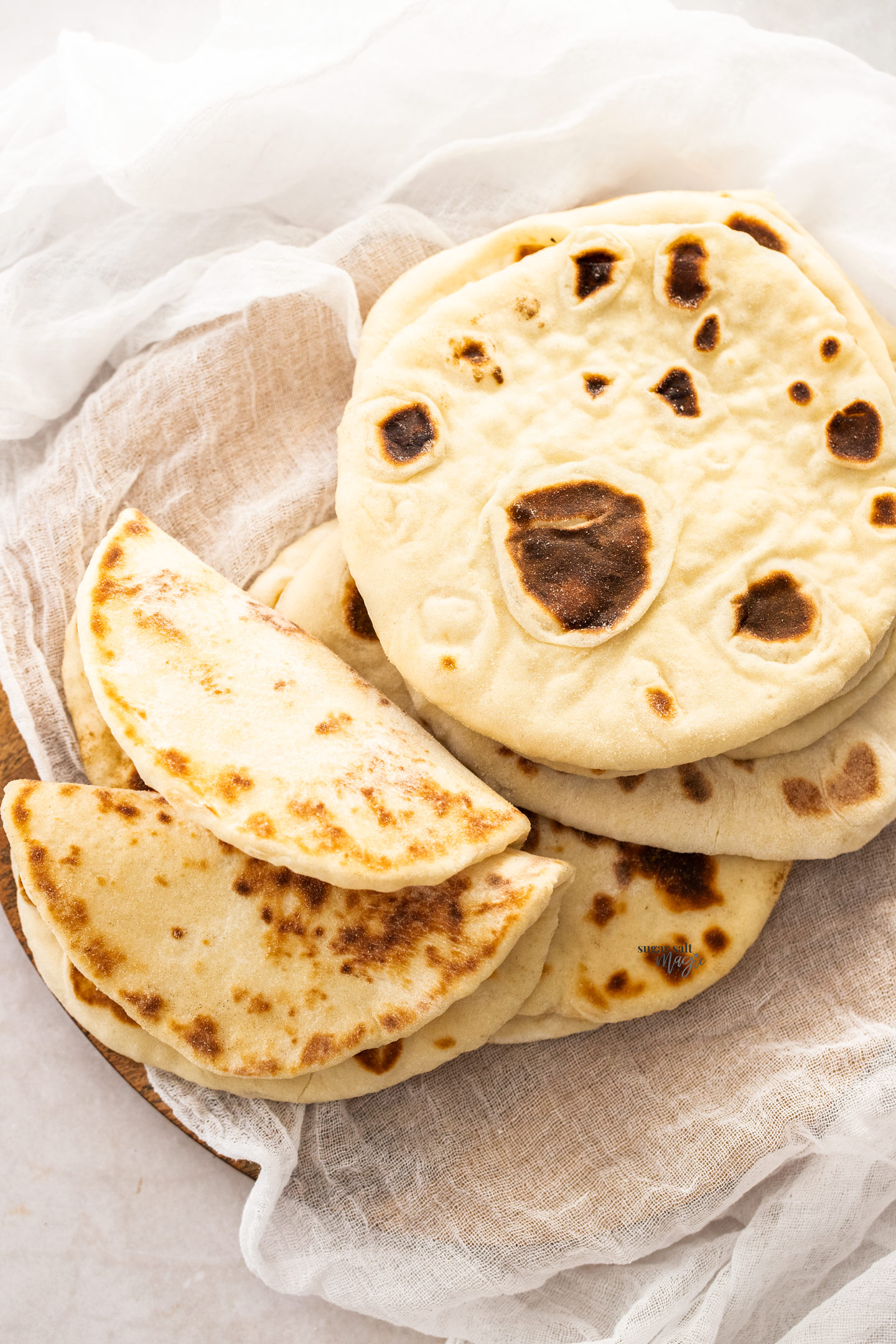
FAQs
This style is called Bazlama but there are other types of Turkish flatbreads too. Turkish pide is a fluffier more bread-style flatbread a little like focaccia. Yufka is a very thin flatbread used for wrapping and making things like gozleme and borek. Lavash is a very thin, crisp flatbread topped with nigella seeds.
No. Bazlama and pita are different, namely in the fact that pita doesn’t generally contain yogurt but also pita is thinner.
Yield and storage
This recipe, as I’ve written it, makes 9 Turkish flatbreads, however you can make smaller, or even bigger ones if you want. As long as you still roll them out fairly thinly (about 3-4mm /⅛ inch) the cooking time should not vary too much.
Bazlama are best eaten fresh and warm. If you have leftovers, store them wrapped well or in an airtight container, at room temperature – not in the fridge where they’ll dry out more.
To reheat them, simply splash a little water on top and reheat in the microwave for 20 seconds. If reheating in the oven, first scrunch up a piece of baking paper and sit it under running water. Squeeze out excess water so the paper is damp and wrap the bazlama (up to 4 flatbreads). Bake in the oven 180C/350F – 5-6 minutes.
Turkish flat bread can be frozen too. Store with a sheet of baking paper between each so they’re easy to separate and inside a large ziplock bag or airtight container.
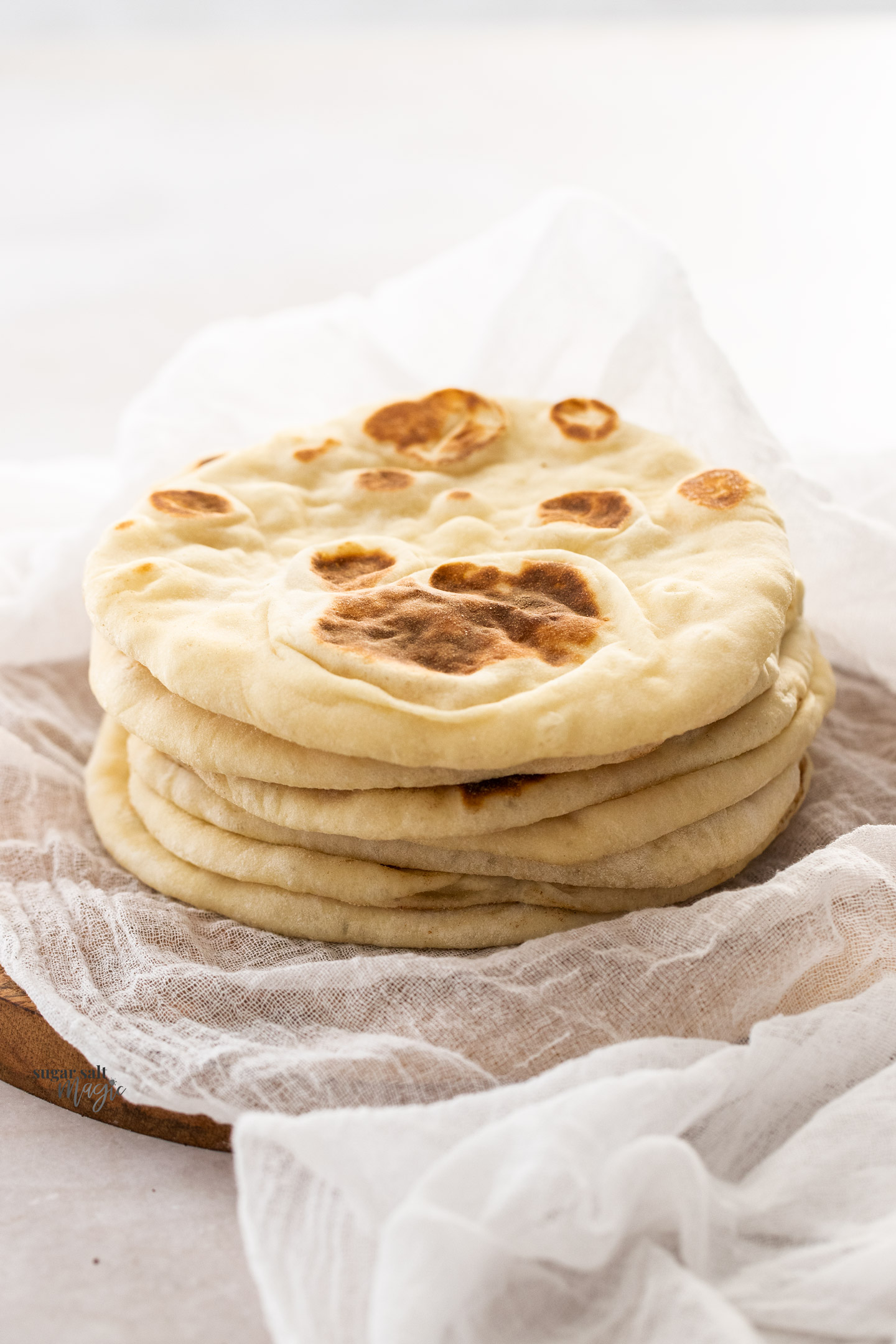
Did you try this recipe for Turkish flatbread?
Leaving a rating and comment below the recipe is so helpful!
Hungry for more? Subscribe to the newsletter for free recipes straight to your inbox. Also, follow along on Facebook, Pinterest and Instagram.
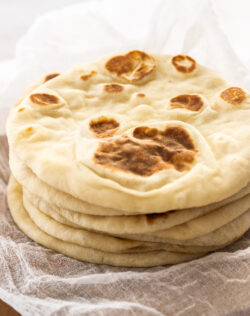
Ingredients
- ¾ cup warm water + 1 tablespoon, if needed (180ml+20ml)
- 3 teaspoons instant dry yeast
- ¾ teaspoon sugar
- 390 g plain flour (all purpose flour) (3 cups/13.8oz)
- ½ cup full fat Greek yogurt (125ml)
- 1 ½ teaspoons salt
- 1 ½ teaspoons baking powder, optional
- Olive oil for greasing
For best results, always weigh ingredients where a weight is provided
Equipment
- stand mixer (optional)
- Frying pan or cast iron skillet
Instructions
- Combine ¾ cup of water, yeast and sugar in a cup and mix to combine. Let it sit for 5 minutes. It should get a bit frothy on top.
- In the bowl of a stand mixer with dough hook attachment (notes for kneading by hand), add the flour, yoghurt, salt, baking powder and yeast mixture. Give them a quick mix using the kneading hook.
- Turn the mixer on low. If the dough has pulled away from the bottom after 1 minute add the extra tablespoon of water; if it’s still sticking at the bottom but pulling away from the sides leave the extra water out. Knead on low for about 5-6 minutes until the dough is starting to look elastic and smooth.
- Dust a clean worktop with just a little flour. Knead the dough for just 30 seconds or so until look smooth. Add a little oil to the stand mixer bowl and place the dough in, flipping it over a couple of times to coat. Place a plate over the top and let it rise for about 1 hour or until doubled in size.
- Without punching down the dough, gently lift it out of the bowl and nudge it to a small rectangle shape. Fold the bottom third over the middle and then the top third down over the top (like folding a letter). You can also just roll it up. Cut into 9 even pieces.
- Holding one of the pieces on your palm, fold it in half then start pinching in the sides until the side on your palm is smooth and you have a little ball. Rest the balls of dough for a further 15 minutes covered with a clean tea towel.
- Heat a non-stick pan or large skillet over medium-high heat. Drizzle a little oil in the pan and lightly wipe with paper towel so you just have a light smear of oil.
- Lightly flour a clean surface and roll out one dough ball to about 18cm (7 inches) wide. Push it aside and roll out two more.
- Once the pan is hot, gently roll the first one again to 18cm (7 inches). Lift it up and brush off the excess flour then place it into the pan. Cook for 1 minute until you see lots of bubbles on top. Flip and cook a further 45 seconds until you see it puff up. Flip again for 10 seconds, then remove from heat to a plate and cover with a clean tea towel.
- Repeat this cooking process for each one, rolling out another ball of dough while one is cooking so you always have 3 rolled and one cooking until they’re all done.
- Please take a moment to leave a comment & rating. It's appreciated and so helpful.
Notes
- For best results, you should always weigh ingredients like flour and sugar. Kitchen scales are relatively cheap but if you can’t weigh the ingredients, use the spoon and level method (don’t scoop).
More Information
These links will take you up to the post – just scroll down to get back to the recipe card.This post may contain affiliate links that earn me a small commission for my referral, at no extra cost to you. Thank you for supporting Sugar Salt Magic.

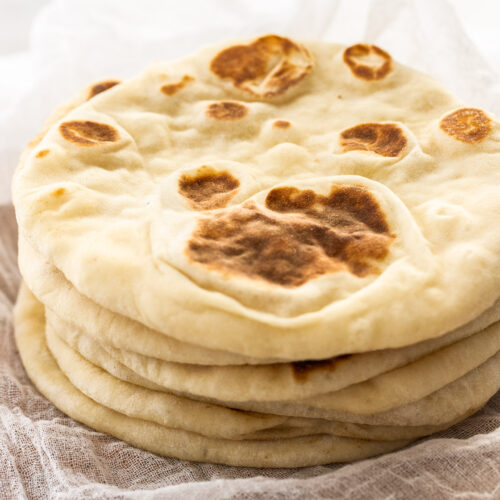
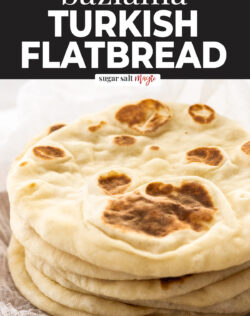

6 Comments on “Turkish Flatbread (Bazlama)”
I always use this recipe and it turns out great every time.
So happy you love it, Steve. Thanks so much for dropping back to leave a review.
This makes the lightest flatbread with great flavor and texture. Added fresh scallions and sesame seeds to the dough. Brushed each side with olive oil before cooking in cast iron. My new go to recipe. Thank you for posting!
I’m so happy you love them, Lauren. Thanks so much for dropping back to leave a review 🙂
I’ve already made these flatbreads twice. It’s such an easy and delicious recipe. I swap half of the AP flour for whole wheat flour, which means you need a bit more water, but that’s about it. This has quickly become my family’s favorite flatbread recipe.
It’s our favourite too, I’m so happy you love them, Chrystyna.